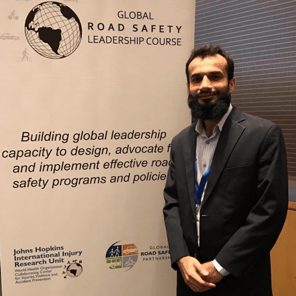 In the latest episode of the Global Road Safety podcast, Tony Douglas and Nate Hanson speak with Dr. Muhammad Navid Tahir who is currently the assistant professor of Public Health at the University of Punjab. He was part of the team that recently drafted national road safety policy guidelines, and is committed to improving road safety in Pakistan.
In the latest episode of the Global Road Safety podcast, Tony Douglas and Nate Hanson speak with Dr. Muhammad Navid Tahir who is currently the assistant professor of Public Health at the University of Punjab. He was part of the team that recently drafted national road safety policy guidelines, and is committed to improving road safety in Pakistan.
Listen to the Episode
On Road Safety in Pakistan
Approximately 30,000 people die from road crashes in Pakistan each year (26 per 100,000 in the population). Despite the severity of the problem, this is not currently identified as a public health issue. But the government took steps to address it with the National Road Safety Strategy in 2018-2030.
This plan looks at the five safety pillars: road safety management, safer vehicles, safer road users, post-crash response, and safer driving environments. Much of the strategy is yet to be put into action.
On Causes of The Road Safety Issues in Pakistan
Dr. Tahir highlights a number of contributing factors to Pakistan's current road safety problem. Including the large population, a lack of integration within public transportation services, and the mix of traffic types (including a large number of non-motorized vehicles) sharing the roads.
It is also difficult to get truly accurate data outside of urban areas because about 65% of crashes happen in certain rural areas where emergency services are less likely to respond.
On Where to Focus The Response
Pakistan has taken a number of positive forward steps, including the implementation of a very good crash response system (Rescue 1122) in three of the provinces. This demonstrates the importance of a coordinated approach in creating a united national and provincial vision for road safety improvements. There has also been an introduction of the modern vehicle inspection and certification system (VICS) for all types of vehicles for the safety of road users.
Dr. Tahir points to road safety education as a key part of increasing driver safety. Which is something that needs to happen at school, at home, and online in order to be effective.
On Changing Driver Behavior in The General Population
Raising awareness in the general population and retraining drivers is a tough task. It's difficult to modify behavior in big cities like Lahore because the roads are very busy and drivers are impatient. There needs to be a concentrated effort to implement road safety training. Some institutional reform is needed in order to standardize the response.
On Lessons From Working with Rescue 1122
Dr. Tahir shares some of the key lessons he would share with people working on improving road safety in other areas of the world. He points to the importance of integrated crash response systems, which is something even countries with low financial capabilities can develop. The data gathered from a good emergency response system can inform other governmental departments, which can guide different areas of policy-making and have a wide impact.
He suggests that this data affects the economy too. Around 50% of emergency beds are occupied by people with road crash injuries, which leads to an estimated 5% loss of GDP as a result.
On Where More Support Is Needed
The World Health Organization (WHO), United Nations (UN), and Asian Development Bank (ADB) are working in close collaboration with the Pakistan government on issues of road safety.
Dr. Tahir believes that there is space for NGOs to augment this with assistance in the areas of road safety awareness and training. He believes they could help to strengthen institutions and systems and improve traffic police in the area of road safety. Outside organizations could also offer technical assistance to improve standards for vehicle safety and road safety auditing.
On Technology and Driver Training
Dr. Tahir observes that commercial drivers don't currently have access to many online resources. But he suggests that private citizens could be a good target for online training and driver awareness. Changing driver behavior will be key in making roads safer. For example, 10% of motorcycle fatalities are the result of head injuries, which Dr. Tahir links back to a reluctance of motorcyclists, especially young people, to wear helmets.
On What Could Be Implemented Tomorrow To Make Roads Safer
Dr. Tahir believes there would be an immediate impact on road safety (approximately 50% fewer crashes) if motorcycles remained separate from other traffic in a dedicated motorcycle lane. The data from other countries such as Malaysia supports this, where there has been a dramatic drop in injuries and fatalities after implementing this.
He also points to the age of drivers as part of the current problem. The fact that many drivers are young (children as young as 10 learn to ride motorcycles), they don't take proper safety precautions, and they take more risks. Around 20-30% of motorcycle drivers in a city like Lahore will be under 17 years of age.
Despite licensing laws, resources are too limited for effective enforcement. When there are approximately 1.5 million motorized journeys every day, it is very difficult for 1500 officials to control all of these vehicles and their drivers.
Resources For Further Exploration
World Bank Road Safety Facility Website
World Health Organization
GRSP
Johns Hopkins International Injury Research Unit
About Our Guest

Dr. Muhammad Navid Tahir
Dr. Muhammad Navid Tahir received his Ph.D. degree (major Public Health) from Queensland University of Technology (QUT), Australia, and a Master’s degree in Public Health Sciences from the Karolinska Institute, in Sweden. As part of his Master’s in International Health, he also attended three Postgraduate Courses on the prevention of HIV, TB, and Malaria. He completed the Global Road Safety Leadership Course organized by the Global Road Safety Partnership (GRSP) and John Hopkins University in 2019.
Dr. Tahir has experience with both public and private international and national organizations and has been involved in Public Health planning, policy analysis, management, monitoring, evaluation, and research for the past several years. Recently, he completed a project with the Asian Development Bank, where he was part of the team that drafted national road safety policy guidelines for Pakistan.








